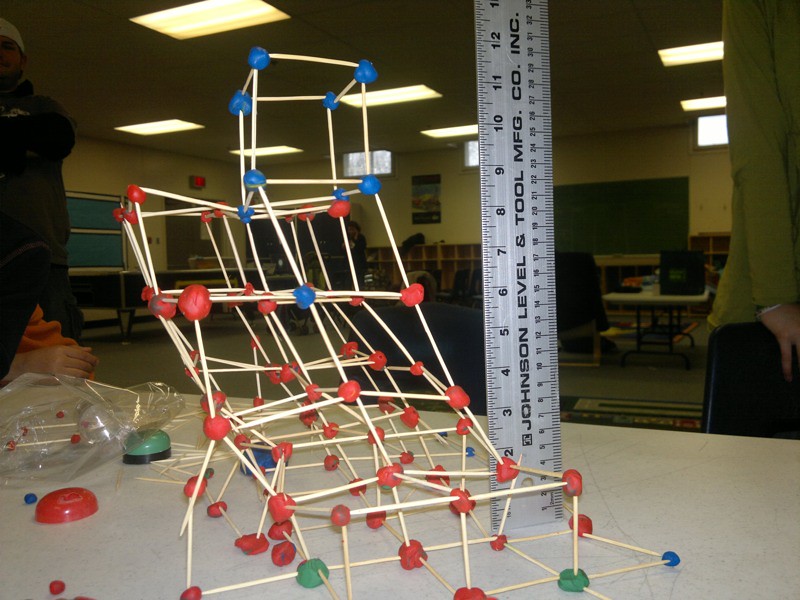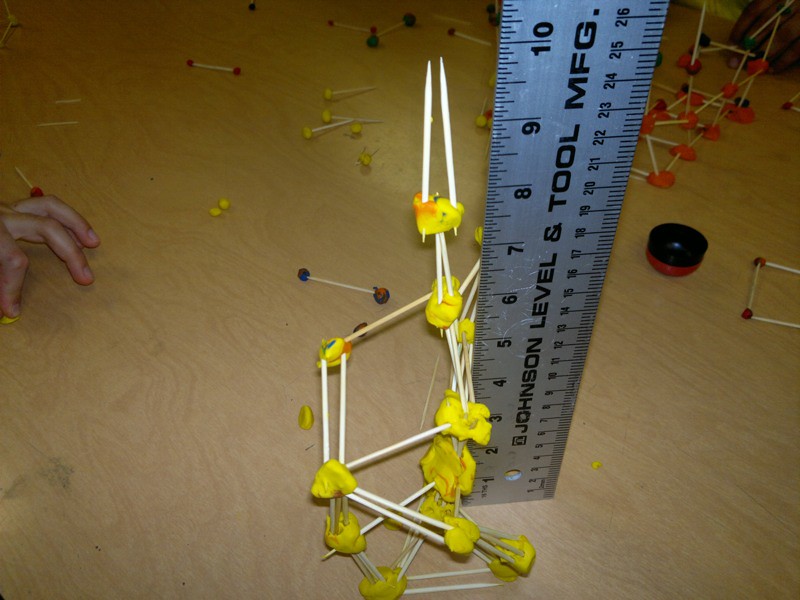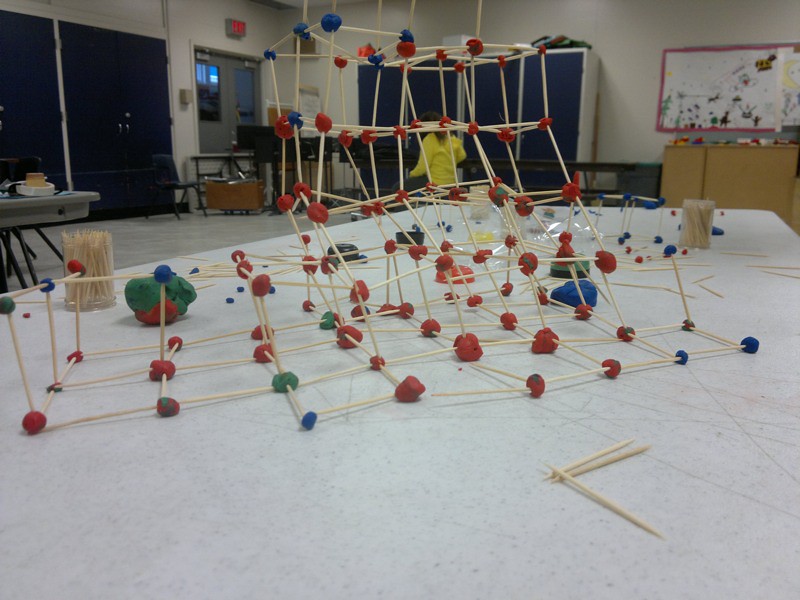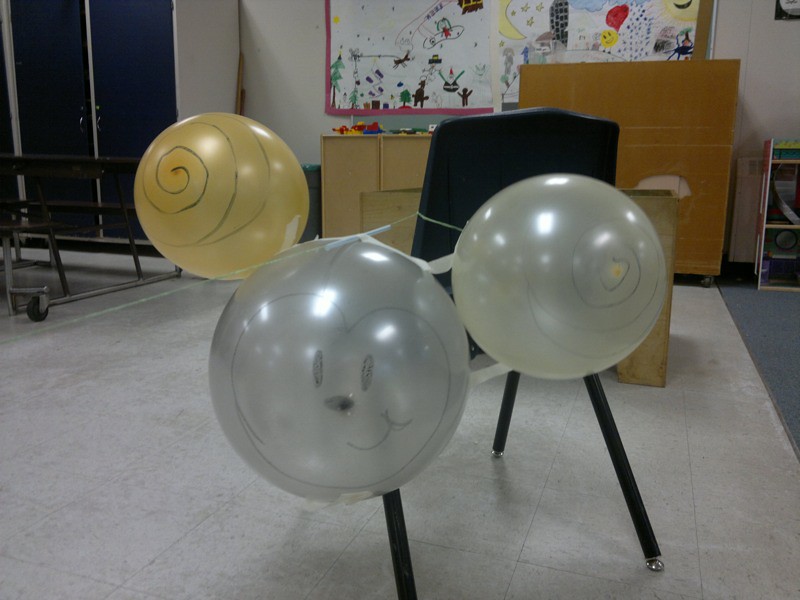For a change, this is going to be a short post!
We bought what we learnt from last weeks Spontaneous Attack session and shared it with the teams. It was challenging, but the kids stepped up to it, and did well. The toughest point was the (quite common rule for spontaneous problems) that if one team member is stuck, the whole team is stuck. We briefly discussed some strategies- like choosing a couple of favorite topics that you know really well, that you can answer almost any question about. We're going to discuss other strategies to try at next weeks session.
And then the two teams moved onto their long term problems. In the structure team, which I co-coach, we started by going over the problem again, particularly the scoring. The team discovered that there are a lot of points available for the style parts of the challenge. It got them thinking about the other parts of the challenge. Then the team decided that they wanted to start building! They used popsicle sticks to try some of their ideas; we all wanted to save our precious balsa wood. The scale might be wrong, but they're easy to work with to try out their design ideas.
One thing that proved really helpful for the structure team was a suggestion from a couple of the other coaches (Sarah and Gail- thanks!): create some sort of analogue of the volumes mentioned in the problem description, for the unfolded and folded states of the structure. I grabbed a box and chopped it up to create three, 3 sided, rectangular 'open' prisms. It really helped the team visualize the dimensions involved.
I only briefly saw our Goldberg team's machine, but from the little I saw I'm excited to see more next week!
Thanks this week to all the parent helpers who stayed- especially Neville, who sorted out my dis-organized story card, Gisela for organizing snacks, and Pam who helped judge some of the spontaneous challenge practices.
A team of parents bringing the Odyssey of the Mind Challenge to Gilmore Elementary, Richmond, BC.
Saturday, February 19, 2011
Monday, February 14, 2011
Spontaneous Attack!
We had the pleasure of having four of our participants attend the Odyssey BC Spontaneous Attack session at South Slope School in Burnaby.
We were greeted by the friendly Odyssey BC volunteers, registered and the kids were moved to our first station, with Bruno as chaperone. Sarah, as part of the coach training, was taken to a station to be partnered with an experienced coach/judge and was put immediately to work running and judging an activity.
Our first station was, I think, a little surprising for our kids. It was more formal than anything we've yet to do in practice, with the 'judge' giving them a copy of the problem description, and then reading out the situation and rules. I was a little worried that the kids might be discouraged or overloaded given the stopwatch, the rules of turn-taking, and the complexity of the problem. I employed what I've been told over and over again: "coach- be quiet", took a deep breathe and watched.
They got it. The 'judge', an experienced coach, was very warm and engaging. She made suggestions, gave examples, and lots of encouragement. Everyone thanked the judge and moved onto the next of about four stations.
From this point on I only saw bits and pieces as I was on baby-watch duty, but Xavier and I did take a peak at all of the stations. There were situational scenarios (given a picture, "what might happen here?"), creative story telling, prop creation, and a structure problem (which looked to be a lot of fun.)
Each 'judge' gave constructive feedback both to the team and the coaches, which I'll try to summarize below:
Given that our participants are both first timers, and young, they did themselves very proud; at times it wasn't easy, but nobody gave up, and everyone listened to the feedback from the people running the stations.
At this point I'd like to say thanks to Bruno for driving and supervising the kids at and between the stations, and also to the wonderful Odyssey BC volunteers and organizers for putting together and running such a great session.
We were greeted by the friendly Odyssey BC volunteers, registered and the kids were moved to our first station, with Bruno as chaperone. Sarah, as part of the coach training, was taken to a station to be partnered with an experienced coach/judge and was put immediately to work running and judging an activity.
Our first station was, I think, a little surprising for our kids. It was more formal than anything we've yet to do in practice, with the 'judge' giving them a copy of the problem description, and then reading out the situation and rules. I was a little worried that the kids might be discouraged or overloaded given the stopwatch, the rules of turn-taking, and the complexity of the problem. I employed what I've been told over and over again: "coach- be quiet", took a deep breathe and watched.
They got it. The 'judge', an experienced coach, was very warm and engaging. She made suggestions, gave examples, and lots of encouragement. Everyone thanked the judge and moved onto the next of about four stations.
From this point on I only saw bits and pieces as I was on baby-watch duty, but Xavier and I did take a peak at all of the stations. There were situational scenarios (given a picture, "what might happen here?"), creative story telling, prop creation, and a structure problem (which looked to be a lot of fun.)
Each 'judge' gave constructive feedback both to the team and the coaches, which I'll try to summarize below:
- coaches can teach the teams strategies for these problems:
- get a book of spontaneous problems
- check out the Pennsylvania Odyssey web site
- get a book of spontaneous problems
- often very successful teams assign members roles such as: timer, reader, builder, coordinator, artist, rules checker/scorer
- during a problem, if needed, the team should figure out and assign any efficient divisions of labour; eg for a structure problem that has re-usable projectiles, assign a couple of people to quickly retrieve and return them to the 'launcher'. It may not be as much fun, but the team will generate more chances of getting higher scores.
- showing and encouraging team spirit and teamwork
- having a motto/chant
- encouraging talk to each other
- let every one take roles and turns
- work together; create one solution, rather than one per team member
- watch the rules
- having a motto/chant
- Prioritization: figure out the key point-scoring tasks, get these done first, then do the extras
- problems are often structured so that each team member must give an answer; if they get stuck, the whole team is stuck. So coach the kids to have two default answers to fall back to if they have a blank.
- listen carefully, and try not to fidget when problem descriptions are read out
- speak clearly, and with good volume when talking to judges and other officials
- if a team has more than five members, pre-decide who will be the five to do the challenge
- use thinking time and the time while others are having their turn to figure out your next answer
Given that our participants are both first timers, and young, they did themselves very proud; at times it wasn't easy, but nobody gave up, and everyone listened to the feedback from the people running the stations.
At this point I'd like to say thanks to Bruno for driving and supervising the kids at and between the stations, and also to the wonderful Odyssey BC volunteers and organizers for putting together and running such a great session.
Friday, February 11, 2011
Teams, Vehicles, Structures, Plays, and PAC Support
It's been a busy couple of weeks, with lots of good achievements- our thanks to all those that helped make them happen!
We had our first practice session, which was well attended both by kids and parents. We all played a couple of ice breaker games, and then we split off into two groups- kids, and parents.
Sarah and the helpers organized the children into two groups and set them their first challenge: build the tallest structure they could using only tooth picks and plastecine. Part of the challenge was a time limit.
At the same time Julian talked with the parents about Odyssey, and what the teams will need from their parents. Right away we had enough volunteers (many thanks to Neville, Pam, Sylvanus, Fion, Bruno, Chris, and anyone else I've forgotten to mention) step up to field a team; and kids for three.
Everyone then admired the structures, and the parents acting as judges gave feedback to the teams.



Then the second challenge: build a vehicle from straws, balloons, and tape that can
get from one side of the room to the other. Both teams tried different strategies, but the Mouse Express (my name) was the best performer.

At the end of the day all the kids commented that teamwork is hard- especially when it comes to sharing ideas.
During the following days enough other volunteers (thanks Deborah, Constantin, and Gisela) came forward allowing us to field a second team. Sarah also presented Odyssey of the Mind to the PAC and asked for funding. Thanks to the other supportive parents present we were granted funding for both this year and next- which is great news!
Our next session had us arranging into potential teams and creating a play which had to use a random assortment of items. Partway through their preparation I was a little worried that this was too big a challenge for either team, but they did it! One team created a play about a Princess going for a walk to chop a tree that ends up jointing the towns band. The other, a dark tale of a young vampire rejecting her Father's feeding habits, and resuscitating one of his victims. They were both spellbinding; taking a bite out of some old jingles; full of cutting insight... ok enough of the puns!
The kids then choose two long term problems (the "Good as Gold...berg" and "Structure" challenges) and re-arranged themselves into teams around them.
And here is where I must draw this post to a close.
We had our first practice session, which was well attended both by kids and parents. We all played a couple of ice breaker games, and then we split off into two groups- kids, and parents.
Sarah and the helpers organized the children into two groups and set them their first challenge: build the tallest structure they could using only tooth picks and plastecine. Part of the challenge was a time limit.
At the same time Julian talked with the parents about Odyssey, and what the teams will need from their parents. Right away we had enough volunteers (many thanks to Neville, Pam, Sylvanus, Fion, Bruno, Chris, and anyone else I've forgotten to mention) step up to field a team; and kids for three.
Everyone then admired the structures, and the parents acting as judges gave feedback to the teams.



Then the second challenge: build a vehicle from straws, balloons, and tape that can
get from one side of the room to the other. Both teams tried different strategies, but the Mouse Express (my name) was the best performer.

At the end of the day all the kids commented that teamwork is hard- especially when it comes to sharing ideas.
During the following days enough other volunteers (thanks Deborah, Constantin, and Gisela) came forward allowing us to field a second team. Sarah also presented Odyssey of the Mind to the PAC and asked for funding. Thanks to the other supportive parents present we were granted funding for both this year and next- which is great news!
Our next session had us arranging into potential teams and creating a play which had to use a random assortment of items. Partway through their preparation I was a little worried that this was too big a challenge for either team, but they did it! One team created a play about a Princess going for a walk to chop a tree that ends up jointing the towns band. The other, a dark tale of a young vampire rejecting her Father's feeding habits, and resuscitating one of his victims. They were both spellbinding; taking a bite out of some old jingles; full of cutting insight... ok enough of the puns!
The kids then choose two long term problems (the "Good as Gold...berg" and "Structure" challenges) and re-arranged themselves into teams around them.
And here is where I must draw this post to a close.
Subscribe to:
Posts (Atom)